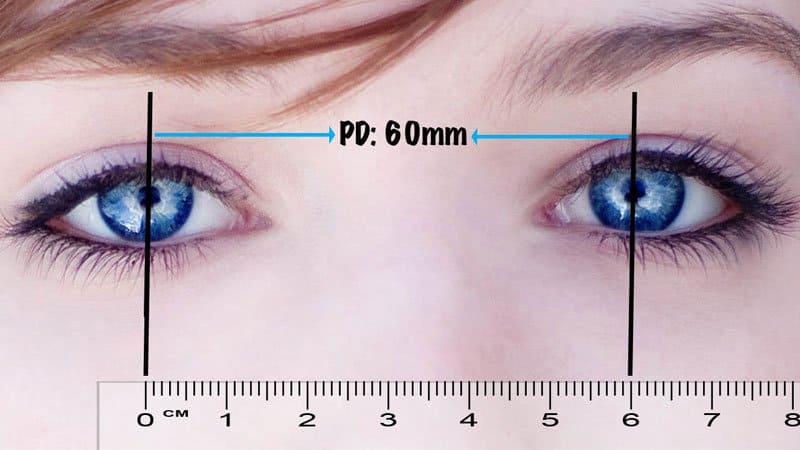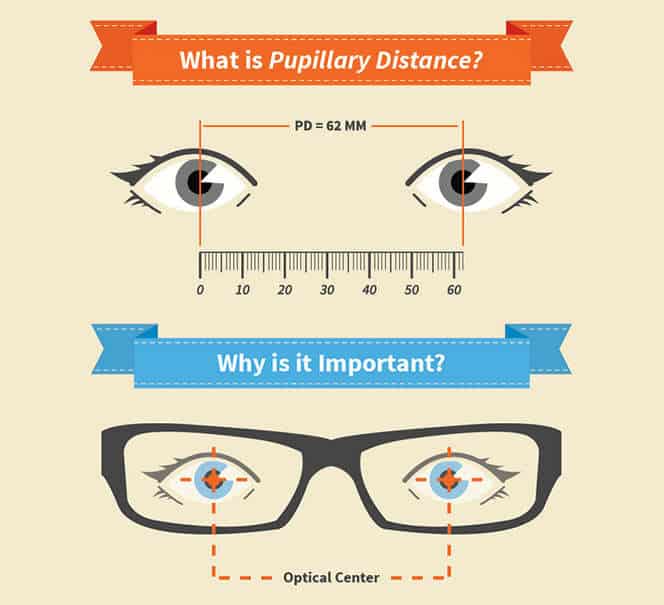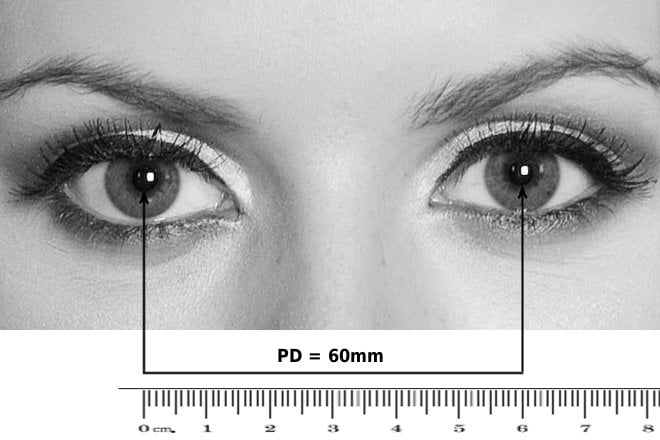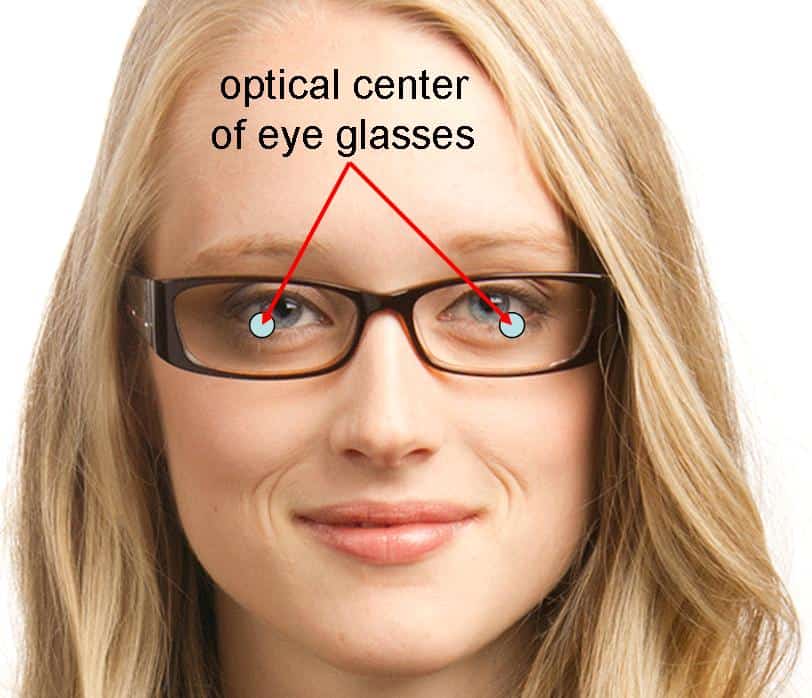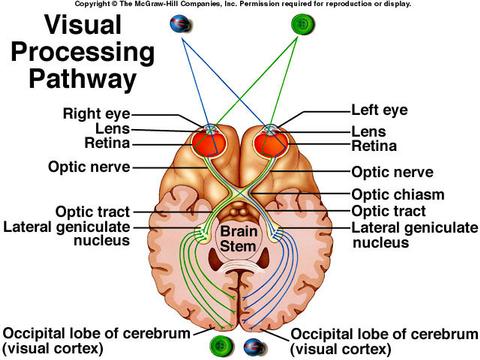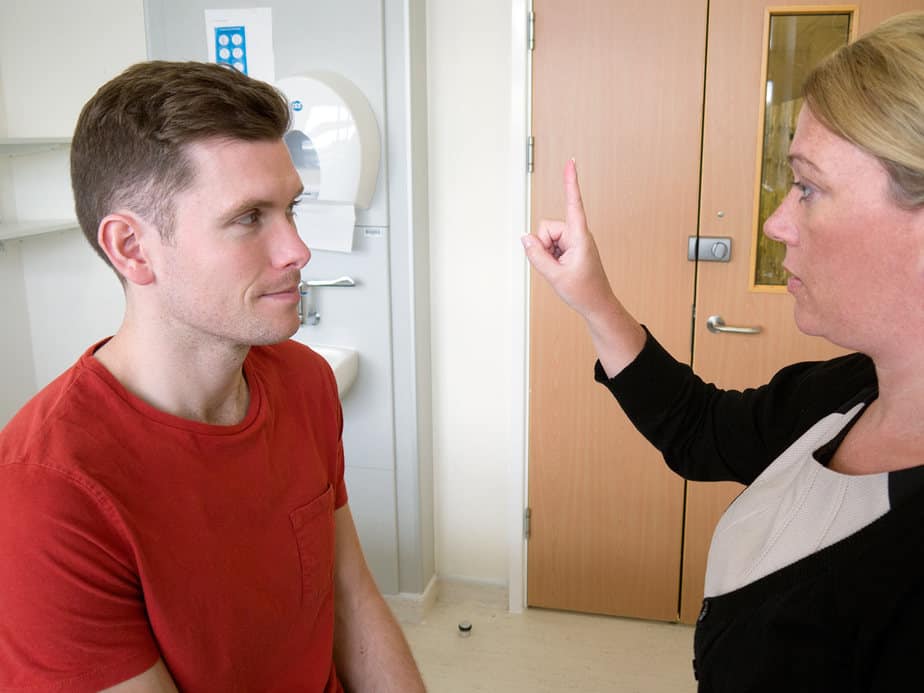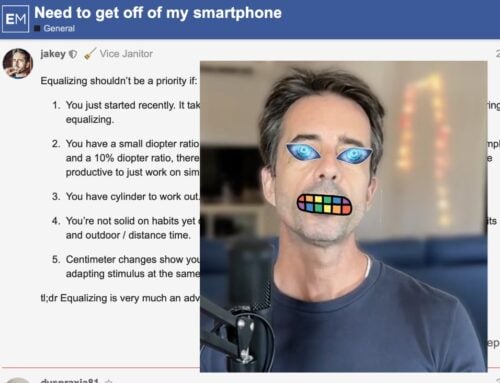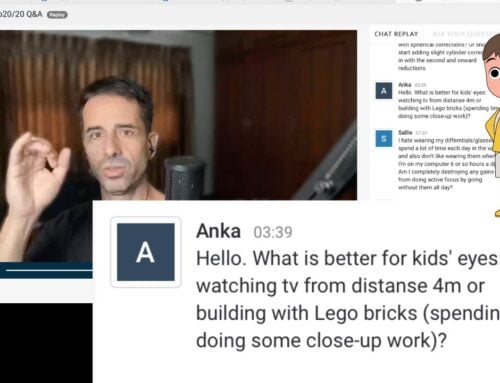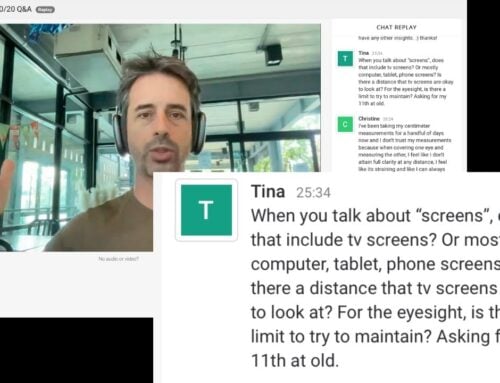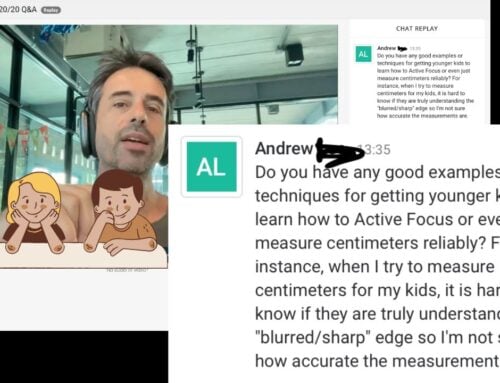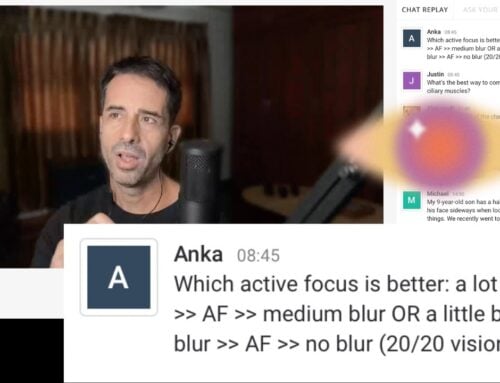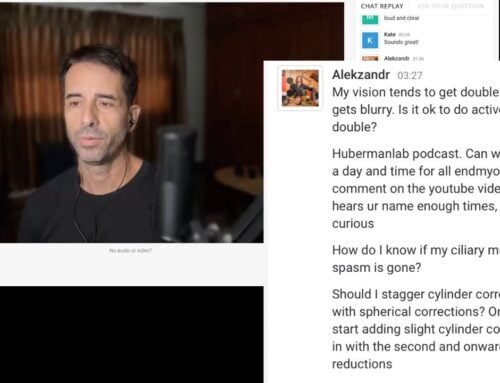PD (pupillary distance) can be an important part of your lens prescription, and notably affect your general well-being.
If you have high myopia, and in particular high myopia and high astigmatism, an incorrect PD value can cause blurry vision, double vision images, headaches, nausea, and fatigue. In particular a small error in PD with a complex prescription might just give you a small headache sometimes, something that might be very vexing and difficult to pinpoint the cause of. I’ve had hundreds of students over the years, who had these symptoms and never realized why!
There is a fairly fundamental problem with PD measurement especially in the high astigmatism / high myopia scenario, which might cause you discomfort that you were never able to figure out.
But, first things first:
What The Pupillary Distance Is
Pupillary Distance (PD) or interpupillary distance (IPD) is the distance (the industry standard is to measure in millimeters) between the centers of the pupils in each eye. This measurement is used when preparing to make prescription eyeglasses. Positioning lenses correctly in relation to the centre of the pupils is especially important for higher powered lenses due to the location of the optical centre of the lenses.
Zenni Optical has a good article on PD, as well, including this handy visual:
The problem with this?
PD is not a static number! Or at least even though it’s measured like it is static, in biological reality, it’s pretty dynamic. Yes, your pupillary distance isn’t always the same. We’ll see in a moment how that works, and how might lead to headaches and fatigue.
First, let’s look at how the measurement of PD works:
How PD Is Measured
Look off into the distance. A ruler is held in front of your face. And just like that, you got your PD.
However, there’s an issue with this. Ooptometrists measure PD for distance vision, only. This means you look at a distant point, the optometrist measures the distance between your pupils. Pretty simple.
This measurement determines how far your pupils are apart, which is then used to determine the optical center of the lenses of your new glasses prescription. Which is where the problems start to converge.
Since your pupillary distance isn’t static, there is a problem with the optical center premise.
Why PD Matters
Let’s first look at when PD doesn’t matter.
If you have a low myopia prescription, and no astigmatism correction, getting PD exactly right isn’t that big of a deal. Of course you don’t want to blindly guess at it, but a millimeter or two either way won’t affect your lens wear notably.
So if that’s you, you’re in the clear.
But if you have a high myopia prescription, and especially if you also have an astigmatism correction, the PD suddenly becomes pretty important. Why?
Because the lens in front of your eye has changing optical properties, depending on where you look through it. You can assess this pretty easily, right now, with your own glasses. While looking at some writing, start moving the glasses slowly, in front of your eyes. See how things become a bit pinched, how the clarity changes, how things look a bit wonky, when you look through the lens at various points other than the optical center?
This is why PD is pretty important. It’s only at the optical center of the lens that you get the intended focal plane. The further you drift from the optical center of the lens, the more the light hitting your retinas is going to be bent in various ways that aren’t going to be “right”.
And that’s when you start not feeling quite right:
How The Wrong PD Will Give You Headaches
With the light bent “wrong” when arriving at your retinas while your PD isn’t right, things aren’t going well. The visual cortex in your brain is working overtime, trying to to “fix” the incorrect visual signal. Like your computer overheating when you tax the CPU with lots of computing, your brain is going to tell you that it’s not dealing well with this work – via fatigue and headaches.
It’s important to remember that vision happens in your brain. So when things go wrong with the visual signal, it’s your headaches that are the most common result.
On to the most troubling part of the PD story:
Your PD Is Wrong
Now you might think, Jake. Jakey Jake. Don’t fear monger my stuff. How would you know about my PD anyway?
Well … remember when I said, PD isn’t static?
Here’s the thing with that. If you look at a distance, your pupils are slightly wider apart, than when you look up close. Think about your eyeballs rotating in your eye sockets, as you look at the world. Or just take your index finger, ask whoever is near you right now, to do a 30 second experiment:
Hold your index finger in front of the person’s eye. Now move the finger further away, and then closer to the person’s face. See it?
Yes. The pupils of the eye are closer together when looking at close-up images. You see where this is going?
Your optometrist measures your PD for distance vision, because myopia is a distance vision deficiency. Your glasses are made for distance vision. But what do you do with your glasses, all day?
You look up close! At your computer.
So now your measured PD, while correct for the intended use, is actually wrong. For close-up, your PD is lower than it is for distance. And before you freak out, tear off your glasses and trample them so much like they suddenly turned into a pile of eyeball eating spider-ants, consider what I told you earlier:
If you’re low myopia, no astigmatism correction, the PD value isn’t that huge of a deal.
Also if you don’t get headaches or fatigue or generally not feeling right, while wearing a high myopia prescription with lots of astigmatism correction – then you’re fine as well. Odds are that you’re fine. This whole thing is mostly relevant if you wear your prescription and after a few hours you just feel headaches or fatigue. Then perhaps, it’s time to look at the PD.
And if you’re still not convinced, here’s another factoid: PD is actually measured separately, for multi-focal prescriptions. Meaning, if you wear glasses that have correction built in for near and far vision, two PD number are collected.
Two PD values. A lower one for reading, a higher one for distance. Now if you remember moving the lenses in front of your eyes, and the index finger pupil experiment, and how your glasses are intended (and measured) for distance vision, it should all come together for you.
Bummer. But why then does optometry often do the PD wrong (ie. just for distance)?
Because that’s the fundamental problem with the single prescription paradigm. Myopia treatment today is still the same that it was 600 years ago. It’s a single, static focal plane correction, with zero regard for root cause, long term side effects, or even the nuances of things like PD, well known as their importance may be today.
How To Get The Right PD
In an ideal world you could walk into your optometrist’s office, and ask for a prescription specific to your close-up needs.
Odds are though that you’ll be looked at incredulously, if you tried that. There are some small odds that you’re lucky (see Robert’s forum post below) and find an insightful optometrist. But otherwise, no cigar. It’s important to realize that there is no malice here, and that arguing with the optometrist won’t benefit you (or him/her) at all. It’s how they’re taught. You can point them to the eye guru Website #endmyopia, and you’ll still just get looked at like you lost your mind. Even with the facts that we just discovered, that’s just how it is.
This leaves you with figuring out your own PD. Which as you probably realized by now, is pretty simple. Measure carefully, order glasses online. Now here too you might run into a snag, since in many places in the world you’re simply not allowed to make your own (even if educated) choices about your own vision health.
Which is where we’ll leave it. Remember, we’re not giving prescription advice here. These are mere musings of pupils and things. The choices you make, are always your own.
Before we go, let’s look at a forum post from today. Robert asks:
I have been to the optometrist for a pair of glasses suitable for computer work. I stated my working distance and also got my pupil distance (PD) measured for the stated working distance. The PD for my computer glasses is smaller than for my normal prescription. Do you recommend using a different PD for Close up work prescription or should I use the same PD for all my glasses? And since I tend to use my computer glasses all day at work (even when not in front of a computer), would a different PD be harmful for my Eyes?
I always say this: Don’t mess with prescriptions, until you are pretty well versed on the subject. And even then, ask in the forum, or if you’re super lucky like Robert, use your brilliant optometrist’s help (rare find, that kind of optometrist).
My response to Robert’s question:
How much is the PD difference? What’s the lens prescription?
Generally speaking, the ideal scenario is a slightly smaller PD for a close-up prescription. This is more relevant for higher corrections and in particular if there is an astigmatism component as well, otherwise less so.
My short little response to Robert’s question probably makes a whole lot more sense, if you made it through this whole long post (well done!).
Cheers,
-Jake

